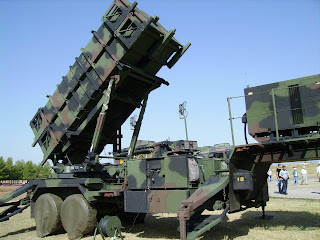 |
| A PAC-3 unit is displayed |
After years of planning, work will officially begin early next month at sites around Greater Taichung and Greater Kaohsiung in preparation for the deployment of Patriot Advanced Capability-3 (PAC-3) air defense units purchased from the US, senior officials said yesterday.
In all, NT$61.4 million (US$2 million) has been set aside from next year’s budget to prepare the sites for four PAC-3 units in the two special municipalities. A private contractor will oversee work at the sites, a Ministry of National Defense spokesman said, declined to provide further information on the engineering contract, citing Government Procurement Act (政府採購法) regulations.
My article, published today in the Taipei Times, continues here.

4 comments:
"...proponents of the system counter that from the beginning, the program was meant to deny Beijing the ability to engage in coercion by threatening limited missile attacks against key infrastructure to intimidate decisionmakers in Taipei."
Could not that function be carried out far more cheaply simply by cannon-fire? Of course, with a more limited range, the cannon would offer lesser protection from warheads carrying nuclear or chemical munitions, but the PAC system was never going to eliminate that threat entirely either.
"...Greater Kaohsiung’s Jenwu District (仁武)..."
That should be "Renwu" district. R, not J. I used to live not far away from there. Not sure where they would put it in Renwu, unless on a brownfield site.
"..Greater Tainan’s Hutoupi (虎頭埤)..."
Xinhua district - "Hutoupi" is just a daft little lake and local "scenic area". Plenty of space out there.
@Mike: TT style is Hanyu for locations in Taipei and Tongyong everywhere else, hence Jenwu, and not Renwu.
On your first question: Missile intercepts are sequential. In this case, PAC-3 or TK-II would attempt an intercept at mid-range; should this fail, other, shorter-range SAMs (e.g, Antelope) and cannon fire would be used. It's multilatered. Plus, it's easier to intercept something before it accelerates upon its descent.
"Missile intercepts are sequential."
Sure. If I may put the question a different way then...
How much improvement in the ratio of successful missile intercepts are we likely to get from PACs over, say, a larger number of cannon and other, cheaper systems?
What I am trying to get at is whether there are grounds to think that the benefit of the PAC system is more psychological (it fires big rods and costs big $) than real.
There is exactly zero doubt that this was part of the calculation, Mike. Same with other "big ticket" acquisitions.
Post a Comment